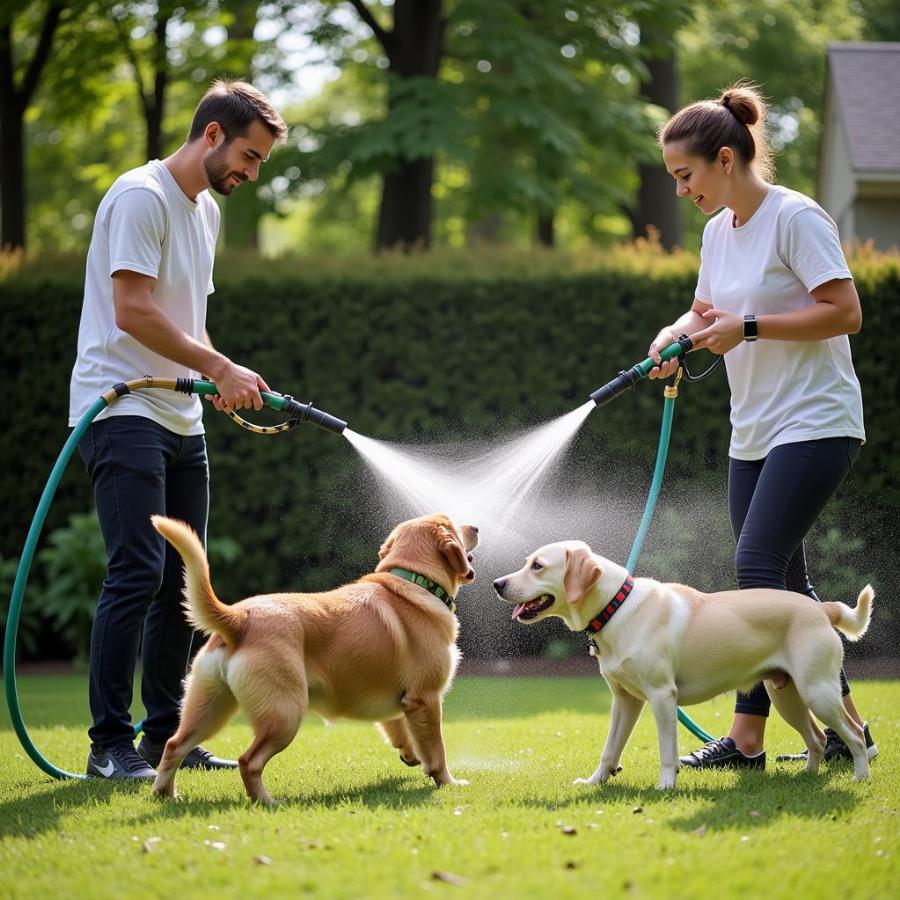A dog fight is a terrifying experience for both the dogs and their owners. It’s crucial to know how to break up a fight safely and effectively to prevent serious injuries. This article will guide you through the steps you should take if you find yourself witnessing this scary situation. Remember, safety comes first. Never attempt to break up a dog fight with your bare hands.
Understanding Dog Fights: Why Do They Happen?
Before we delve into the “how-to,” it’s essential to understand the “why” behind dog fights. Dogs are naturally social animals, but certain situations can trigger aggression, leading to a fight. Here are some common reasons:
- Territoriality: Dogs are protective of their space and possessions.
- Fear or Anxiety: A scared dog may lash out defensively.
- Prey Drive: Some breeds have a strong instinct to chase and catch smaller animals.
- Lack of Socialization: Dogs who haven’t been properly socialized may not understand canine communication cues.
- Resource Guarding: Some dogs become possessive over food, toys, or even their owners.
How to Safely Break Up a Dog Fight: A Step-by-Step Guide
Witnessing a dog fight can be panic-inducing, but it’s vital to stay calm and act quickly. Here’s what to do:
-
Assess the Situation: Before intervening, quickly assess the situation. How many dogs are involved? Are they familiar with each other? What triggered the fight?
-
Make Loud Noises: Start by trying to distract and startle the dogs. Clap your hands, yell loudly, or bang pots together. The goal is to create a distraction that breaks their focus.
-
Use a Barrier: If noise alone doesn’t work, find a large, sturdy object to use as a barrier. A garbage can lid, a piece of plywood, or even a folded lawn chair can be effective. Position the barrier between the dogs to separate them.
 Spraying a hose to stop a dog fight.
Spraying a hose to stop a dog fight.
-
Try Water or Citronella Spray: If you have a hose or a spray bottle filled with water or a citronella solution, spray the dogs in the face. The unpleasant sensation might be enough to break up the fight.
-
The Wheelbarrow Method: If two people are present, each person can grab the hind legs of one dog and lift them off the ground like a wheelbarrow. Then, carefully walk the dogs backward, separating them.
Important: Avoid grabbing collars or the front legs, as this can lead to bites.
What NOT to Do During a Dog Fight
- Never put yourself in harm’s way. Do not try to physically separate the dogs with your hands.
- Avoid screaming or panicking. Dogs can sense your fear, which may escalate the situation.
- Don’t hit or kick the dogs. This will only make them more aggressive.
After the Fight: Safety and Next Steps
-
Separate the Dogs: Once the fight is over, immediately separate the dogs and secure them in different areas.
-
Check for Injuries: Carefully examine both dogs for injuries. Look for bites, scratches, or limping. Contact your veterinarian immediately if you notice any wounds.
-
Seek Professional Help: Consider consulting with a certified dog trainer or behaviorist. They can help you understand the underlying causes of the aggression and create a plan to prevent future incidents.
Preventing Dog Fights: Proactive Measures
- Socialization is Key: Properly socialize your dog from a young age. Expose them to different people, dogs, and environments.
- Know Your Dog’s Triggers: Pay attention to your dog’s body language. If you notice signs of stress or anxiety in certain situations, avoid them or manage them carefully.
- Train and Reinforce: Teach your dog basic obedience commands like “leave it,” “come,” and “drop it.” These commands can be invaluable in preventing or de-escalating potentially dangerous situations.
- Spay or Neuter: Spaying or neutering can reduce hormone-driven aggression in dogs.
When to Consult a Professional
If you’re concerned about your dog’s behavior or if a dog fight has occurred, don’t hesitate to seek professional help. A certified dog trainer or veterinary behaviorist can provide guidance and develop a tailored plan to address the issue.
Beaut Dogs: Your Resource for Dog Care
For more information and resources on dog behavior, training, and care, visit Beaut Dogs. We’re dedicated to providing dog owners with the knowledge they need to build strong, loving bonds with their furry companions. When in doubt, reach out to our team at [email protected] for specific guidance on your unique situation. We’re here to help!